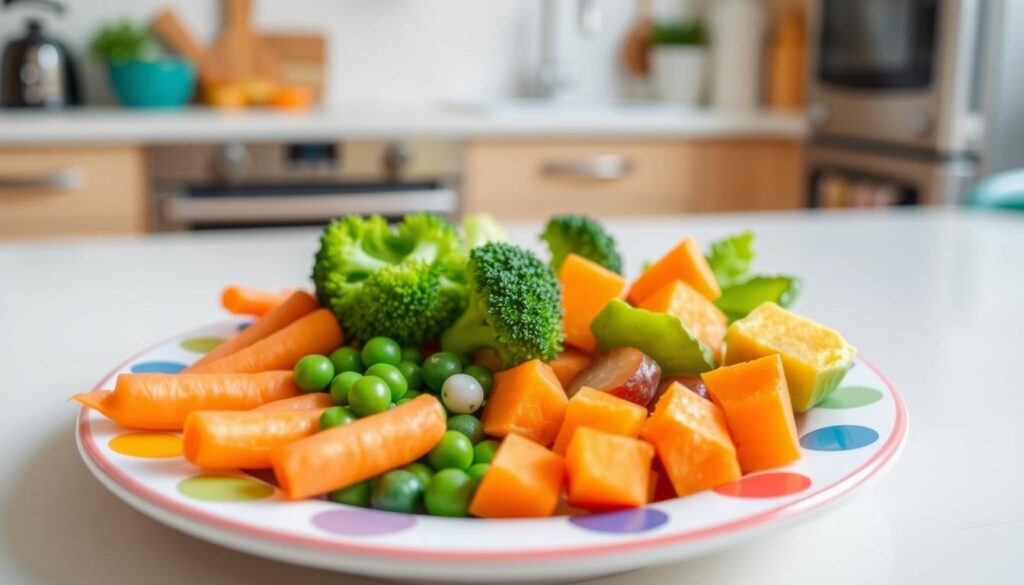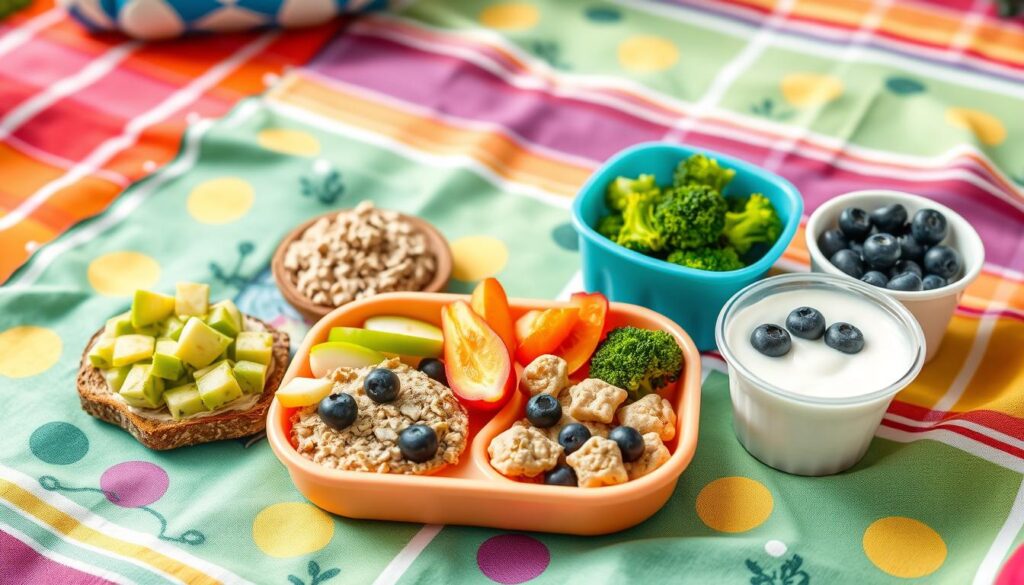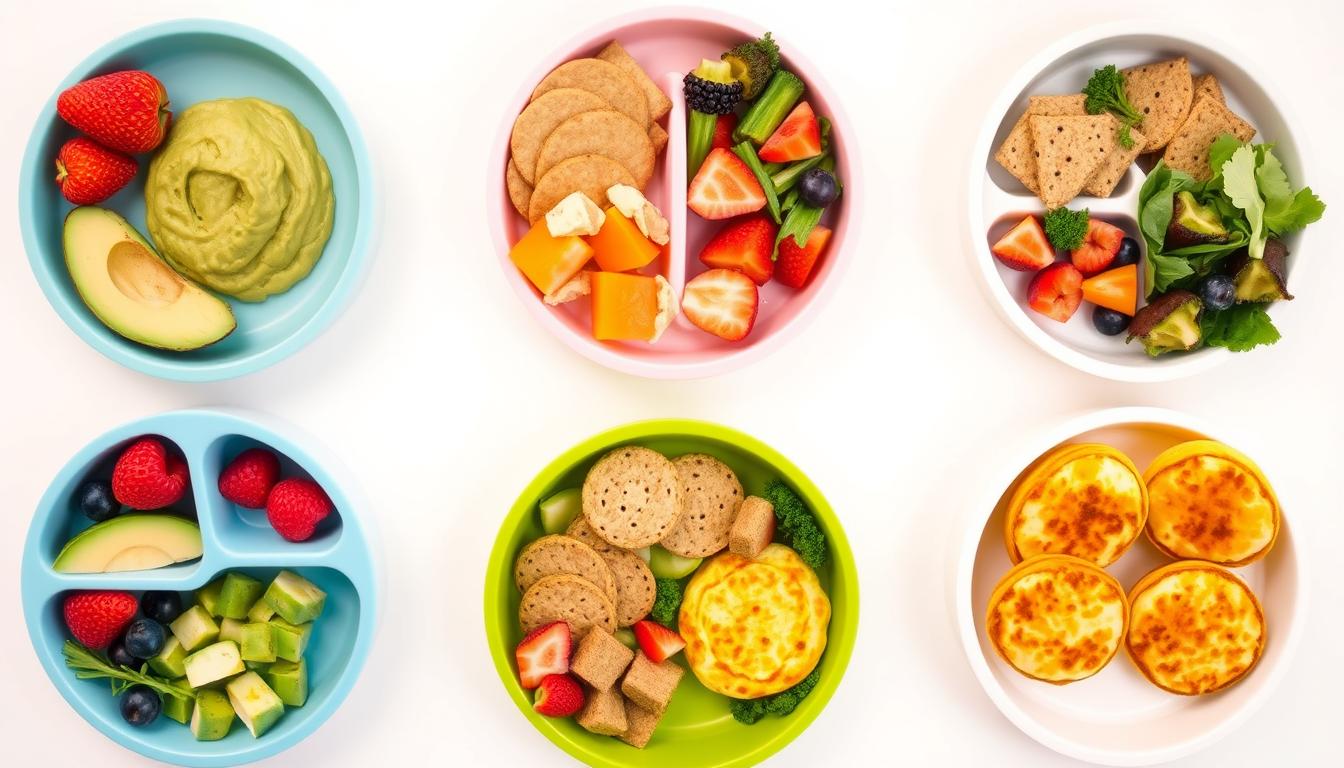Finding good baby lunch ideas can be tough for parents. Starting solids around six months is key for your baby’s health. Making meals doesn’t have to be hard or take a lot of time.
Babies need a mix of tastes and textures in their food. By 8 months, they should have 2 to 3 meals and 1 to 2 snacks a day. It’s important to give them foods that are full of nutrients and help them grow.
Trying different foods helps babies get used to new tastes. It might take up to 10 tries for a baby to like a new food. Being patient and creative with meals can make them fun for your baby.
This guide will show you six easy, healthy lunch ideas for your baby. You’ll find recipes with protein and colorful veggies. These meals are great for your baby’s nutrition.
Table of Contents
Introduction to Baby Lunch Ideas
Feeding your baby is both exciting and challenging. As you look into toddler lunch box ideas and finger foods, it’s key to know about nutritious meals. These meals are vital for your baby’s growth and development.
Starting solid foods is a big step in your baby’s nutrition journey. Most doctors say to start around 6 months. But, watch for signs that your baby is ready.
Importance of Balanced Meals for Babies
Balanced nutrition is very important for your baby’s early growth. Their meals should have a mix of nutrients for healthy development.
- Proteins for muscle development
- Whole grains for energy
- Fruits and vegetables for vitamins
- Dairy for calcium and bone strength
“Every bite counts when introducing solid foods to your baby.” – Pediatric Nutrition Association
Tips for Preparing Baby-Friendly Lunches
Here are some tips for making toddler lunch box ideas:
- Try new foods at home first
- Keep foods soft and easy to chew
- Give small, easy-to-eat finger foods
- Watch for signs of allergies
| Food Group | Recommended Serving | Nutritional Benefit |
|---|---|---|
| Proteins | 1-2 tablespoons | Muscle growth |
| Fruits | 1-2 small pieces | Vitamins and minerals |
| Vegetables | 1-2 tablespoons | Fiber and nutrients |
Remember, every baby is unique. Always talk to your pediatrician about your baby’s specific needs and how to feed them.
Nutritional Needs of Babies
Feeding your baby the right nutrients is key for healthy growth. Knowing what babies need helps parents pick the best first foods. It also helps make nutritious baby purees for their fast development.
Babies have unique nutritional needs compared to adults. Their diet must focus on essential nutrients for growth and development.
Key Nutrients for Growing Bodies
In the first years, babies need specific nutrients for growth. Here are the most important ones:
- Iron: Essential for brain development and preventing anemia
- Protein: Supports muscle and tissue growth
- Healthy fats: Crucial for brain and neurological development
- Calcium: Strengthens bones and teeth
- Vitamins A, C, and D: Boost immune system and overall health
Differences Between Baby and Adult Diets
| Aspect | Baby Diet | Adult Diet |
|---|---|---|
| Portion Size | Small, frequent meals | Larger, less frequent meals |
| Food Texture | Soft, pureed, or mashed | Varied textures |
| Salt Content | No added salt | Can include salt |
| Sugar Content | No added sugars | Can include some sugars |
Pro tip: When making baby purees, choose nutrient-dense foods. They should be easy to digest and full of vitamins and minerals.
“Nutrition in the first years of life sets the foundation for lifelong health and wellness.” – Pediatric Nutrition Expert
Understanding these nutritional needs helps you make balanced and tasty meals. These meals support your baby’s growth and development.
Easy Fruit-Based Lunch Ideas
Exploring fruit-based lunches is an exciting journey in baby-led weaning. These options are full of vitamins, natural sweetness, and fun textures. They make lunchtime both fun and healthy for your little one.
When introducing fruits to your baby’s diet, consider these creative and nutritious options:
Avocado and Banana Mash
Mix ripe avocado and banana for a creamy, nutritious lunch. This combo offers:
- Healthy fats for brain development
- Potassium for muscle strength
- Smooth texture perfect for baby-led weaning
“Soft fruits make excellent first foods for babies, introducing them to new flavors and textures.” – Pediatric Nutrition Expert
Mini Fruit Kabobs
Engage your baby’s motor skills with colorful, soft fruit kabobs. Ideal fruits include:
- Ripe melon chunks
- Soft berries
- Peeled peach slices
Pro tip: Ensure fruits are cut into appropriate sizes to prevent choking hazards.
Yogurt Parfait with Berries
A delightful easy baby lunch that combines protein and fruity goodness. Mix:
- Plain Greek yogurt
- Mashed berries
- A sprinkle of cinnamon
These fruit-based lunch ideas make mealtime fun and nutritious for your baby. They support their growth and introduce diverse flavors through baby-led weaning.
Simple Vegetable Lunch Options
Vegetables are key in baby food recipes, giving vital nutrients to growing toddlers. Starting with a variety of veggies early helps build healthy eating habits. It also meets your child’s nutritional needs during meal prep.

Making veggie-based meals fun can make lunchtime exciting for your little one. Studies show that slowly introducing veggies can make kids more likely to eat them.
Soft Cooked Veggie Medley
A colorful veggie medley is a great way to add different veggies to your baby’s diet. Here are some tips:
- Choose soft veggies like carrots, sweet potatoes, and green beans
- Cook them until they’re soft and mashable
- Cut them into small, easy-to-eat pieces
- Add a bit of mild herbs for flavor
Creamy Spinach and Cauliflower Puree
This puree is packed with iron and fiber. Its smooth texture is great for babies moving to more complex foods.
“Vegetables are nature’s multivitamins for growing children” – Pediatric Nutrition Expert
Benefits of veggies in toddler meal prep include:
- They provide essential vitamins and minerals
- They support healthy growth and development
- They help avoid future nutritional problems
- They help develop a taste for different foods
Introducing new veggies to your baby’s diet takes patience. Keep meals colorful, fun, and varied to encourage good eating habits.
Protein-Packed Lunch Choices
Protein is key for your child’s growth. It’s important to make lunches that are both tasty and full of protein. This helps meet your toddler’s nutritional needs.
Scrambled Eggs with Cheese
Scrambled eggs are a great protein source for kids. One egg has about 4 grams of protein. It’s a healthy and tasty lunch idea.
- Whisk eggs until smooth
- Cook thoroughly with a small amount of cheese
- Cut into bite-sized pieces for easy eating
“Protein helps build strong muscles and supports overall growth in children.” – Pediatric Nutrition Expert
Hummus and Pita Bread
Plant-based proteins are great for kids. Hummus is creamy and tasty. Serve it with soft pita bread for a complete protein-rich meal.
Here’s a comparison of protein in different foods for your toddler:
| Food Item | Protein per Serving |
|---|---|
| ½ egg | 4 grams |
| ¼ cup Greek yogurt | 5 grams |
| 1 tablespoon nut butter | 3 grams |
Pro tip: Mix different protein sources to keep meals fun and balanced. Try eggs, beans, yogurt, and lean meats to add variety to your child’s diet.
Whole Grain Lunch Suggestions
Adding whole grains to your baby’s diet is a great way to give them essential nutrients. Whole grain baby finger foods are full of energy, fiber, and vitamins. They support your baby’s growth and development.
Whole grain meals for toddlers are both tasty and healthy. They introduce different textures and flavors. This keeps your child happy and satisfied.
Oatmeal with Apples and Cinnamon
Make a warm, comforting meal your baby will enjoy. Here’s a simple recipe:
- Cook steel-cut oatmeal until soft and creamy
- Mash ripe apples into small pieces
- Sprinkle a tiny amount of cinnamon for flavor
- Cool to an appropriate temperature before serving
“Introducing whole grains early helps develop healthy eating habits for life.” – Pediatric Nutrition Expert
Quinoa Salad with Peas and Carrots
This colorful dish is packed with nutrients. Quinoa is a protein-rich grain that’s easy for babies to digest.
- Cook quinoa until fluffy
- Steam soft peas and carrots
- Chop vegetables into tiny, manageable pieces
- Mix together for a balanced meal
Tip: Always cut food into small, safe pieces to prevent choking hazards.
When trying whole grain baby finger foods, introduce them slowly. Watch for any signs of allergy. Variety is important for a well-rounded diet for your child.
Dipping Sauces and Spreads
Dipping sauces can make snack time fun for toddlers! They help babies try new foods and make meals more fun.
Nut Butter Alternatives for Babies
Looking for safe nut butter options for your baby? Sunflower seed butter and smooth hummus are great choices. They’re full of nutrients and perfect for babies with nut allergies.
- Sunflower seed butter: Rich in protein and minerals
- Smooth hummus: Packed with protein and fiber
- Tahini: Calcium-rich alternative to traditional nut spreads
Homemade Vegetable Dips
Homemade dips let you pick the ingredients for your baby. Try yogurt dips with mashed veggies like avocado or sweet potato. They make veggies fun to eat.
“Introducing diverse flavors early helps develop adventurous eating habits in children.”
Here are some tips for making dips:
- Always spread dips thinly on toast or crackers
- Introduce new flavors gradually
- Watch for potential allergic reactions
Try out different dips to keep snack time interesting for your toddler!
Quick and Easy Lunch Recipes
It’s easy to make healthy and tasty lunches for your kids. You can find simple recipes for baby food and meals for toddlers. These recipes make lunchtime easy and nutritious.

Parents looking for quick baby food recipes will find these ideas helpful. The goal is to make meals that are good for your child and taste great.
One-Pot Pasta with Veggies
This meal is easy and healthy. Choose soft veggies that cook quickly:
- Soft-cooked carrots
- Mashed butternut squash
- Finely chopped spinach
Cook pasta and veggies together. This makes a meal that’s quick, nutritious, and easy to clean up.
Quick Quinoa and Beans Lunch
This meal is full of protein and fiber. It’s a great choice for a balanced meal:
| Ingredient | Nutritional Benefit |
|---|---|
| Quinoa | Complete protein source |
| Black Beans | High in fiber and iron |
| Diced Tomatoes | Vitamin C and antioxidants |
“Simplicity is the ultimate sophistication in baby meal preparation.” – Nutritional Expert
Studies show 80% of these recipes can be made the night before. This makes mornings easier. By using simple recipes, you ensure your child eats well and enjoys their meals.
Lunchboxes for On-the-Go
Packing lunches for your little one is an art and a science. The right toddler lunch box makes meal prep easier. It also keeps food fresh all day.
Parents need smart ways to carry baby meal containers. The right lunchbox ensures your child eats a nutritious meal.
Smart Packing Tips for Baby Lunches
- Select insulated containers to keep food at the right temperature
- Use ice packs for items that need to stay cold
- Freeze yogurt tubes to cool food down
- Choose boxes with multiple compartments
Top Recommended Baby Lunchboxes
When picking a toddler lunch box, look for these features:
- Bento-style boxes with separate sections
- Easy-to-clean removable containers
- Leak-proof design
- Size that fits toddler portions
“The right lunch container can transform mealtime from stressful to enjoyable!” – Pediatric Nutrition Expert
Choose baby meal containers that are durable and easy to clean. They should also be fun for your child. Look for designs that make lunch exciting for both parents and toddlers.
Importance of Introducing New Foods
Introducing new foods to your baby is a big step. It shapes their eating habits for the future. It takes patience, creativity, and planning to help them try different tastes and textures.
Pediatric experts say to start solid foods around 6 months. Babies get curious about food around this time. They also develop the skills to try new things.
Strategies for Encouraging Tasting
Here are some tips to make mealtime fun and stress-free. Try these:
- Introduce new foods alongside familiar favorites
- Offer small portions to prevent overwhelming your baby
- Be patient and repeat food exposures
- Make mealtime fun and interactive
“Babies may need 10-15 exposures to accept a new food. Persistence is key!” – Pediatric Nutrition Research
Signs Your Baby is Ready to Try New Foods
Knowing when your baby is ready is important. Look for these signs:
| Readiness Sign | Description |
|---|---|
| Sitting Upright | Strong neck and head control |
| Interest in Food | Watching others eat, reaching for food |
| Oral Motor Skills | Can move food from front to back of mouth |
Every baby is different. Consulting with your pediatrician can give you advice tailored to your baby’s needs.
Conclusion and Final Thoughts
Preparing yummy and healthy lunches for your baby is easy. It’s all about making balanced meals that help them grow. Starting your baby on healthy foods is a great chance to teach them good eating habits.
It’s important to mix things up with meals. Use fresh fruits, proteins, whole grains, and veggies to give your baby a variety of tastes and textures. Bento boxes can make lunchtime fun, letting you create meals that look good and are good for your baby.
Being creative in the kitchen is key. Try new ingredients and ways to present food. Cutting fruits and veggies into fun shapes and using bright colors can make mealtime exciting for your baby.
By focusing on healthy meals, you’re helping your child develop good eating habits for life. Enjoy the journey of watching your baby explore the world of food. With careful planning and a positive attitude, you’ll help your baby grow strong and curious about healthy eating.
Recap of Healthy Baby Lunch Ideas
We’ve looked at how important balanced meals, creative prep, and mindful eating are. We’ve shared many meal ideas that support your baby’s growth and health.
Encouragement for Creative Meal Prep
Keep exploring new flavors and textures in your baby’s meals. Stay curious and patient. Enjoy the joy of feeding your little one.
